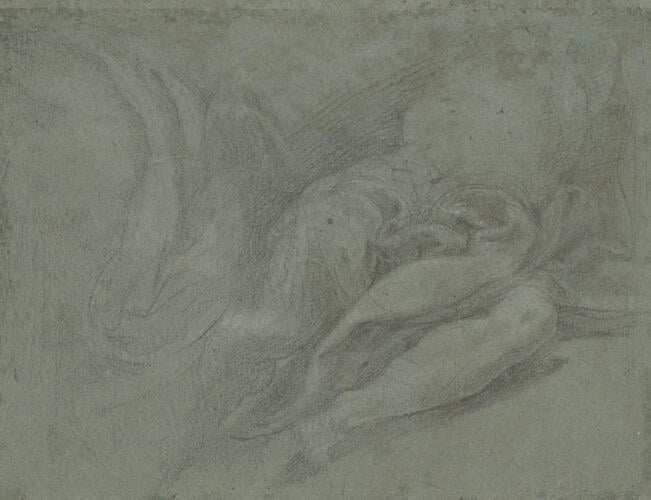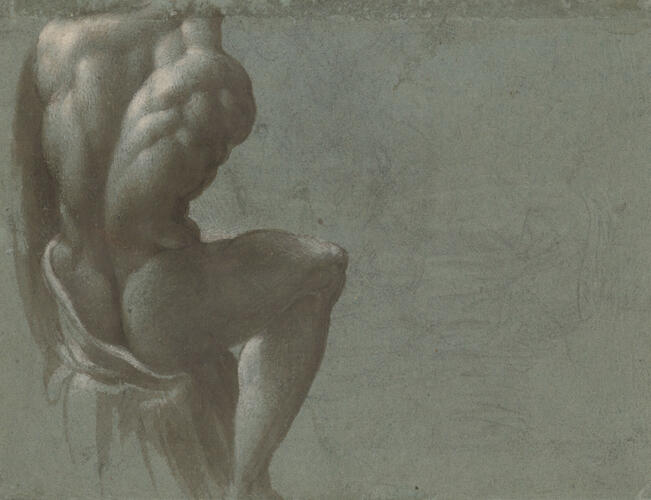-
1 of 253523 objects
A study of St Jerome, recumbent c. 1525-7
Black and white chalks on blue paper. Verso: Brush in brown ink and white lead, over black chalk, on blue paper | 19.3 x 25.0 cm (sheet of paper) | RCIN 900883
-
A study for the drapery and legs of the recumbent figure of St Jerome in The Madonna and Child with St John the Baptist and St Jerome, in the National Gallery, London.
The drawing is a study of torso and legs of St Jerome, with drapery arranged over the loins and between the legs. The form of the body, so far as it goes, is almost exactly that of the painting, and the edge of the painted composition is indicated to the right – this is unusual in a figure study of this kind, and indicates that the drawing was done at a late stage in the planning process. The drapery in the more finished study is considerably more florid than in the painting, with ripples over the loins, and more drapery flowing down between the legs. To the left is a larger, fainter study of the drapery to the left, that corresponds more closely – so far as it goes – with the painting, with a smoother swag of drapery between the legs. It is difficult to determine from the drawing whether it was cut down, and this larger study once extended further, or whether Parmigianino was looking at a limited section of the drapery in this study.The technique - black and white chalks on blue paper - is unusual for a Roman drawing of the 1520s: there was not much use of blue paper in Rome at that time, though artists such as Perino del Vaga were using toned and prepared papers for some of their drawings. Parmigianino's technique might explain the puzzling provenance of the sheet. It was mounted among the Domenichino drawings, more than 1700 sheets that had largely come from Domenichino’s workshop at his death, and had passed down through his pupil Francesco Raspantino to Carlo Maratti, thence to Alessandro Albani, and purchased by George III in 1762. Unlike the Carracci drawings at Windsor, which are very motley, the Domenichino sequence is largely unadulterated, though there are a few drawings clearly added at a later date. This is one such, and perhaps the use of black and white chalks on blue paper (a characteristic technique of Domenichino’s) persuaded a later collector to add it to that sequence. The drawing was not included by Pope-Hennessy in his catalogue of the Domenichino drawings at Windsor; instead it was catalogued by Blunt (1960) as Anonymous Roman, C17th. Parmigianino's authorship was subsequently recognised by Konrad Oberhuber and Philip Pouncey.
On the verso is a study of a sculpture, based on the antique 'Torso Belvedere' but with the lower right leg restored. The drawing, in heavy brush and ink, has not been generally attributed to Parmigianino, though if by an artist present in his Roman studio, this raises the issue of Parmigianino's use of assistants at this period. The form of the sculpture is known in a small bronze statuette of the period, and is seen held by Fabio Licinio in the portrait of the family of Arrigo Licinio, painted by Arrigo's brother Bernardino, c.1530, in the Borghese Gallery. Parmigianino had a clear interest in sculpture and small sculptural models, and this drawing provides tangential evidence for Parmigianino's use of small wax or clay models in his development of the St Jerome altarpiece, particularly the strongly three-dimensional form of St John the Baptist.
Provenance
First recorded in a Royal Collection inventory of c.1800-1820 (Inv. A, p. 91: as Domenichino; among 50 drawings 'Also for Pictures dispers'd in various Cabinets'). Possibly acquired by George III in 1762 as part of the collection of Cardinal Alessandro Albani, along with the Domenichino drawings, though it is not known when the drawing was placed among the Domenichinos.
-
Medium and techniques
Black and white chalks on blue paper. Verso: Brush in brown ink and white lead, over black chalk, on blue paper
Measurements
19.3 x 25.0 cm (sheet of paper)
Category
Object type(s)
Other number(s)

